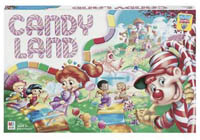by Allan Sugarbaker
 Candy Land
Candy Land
Published by Milton Bradley/Hasbro
Designed by Eleanor Abbott
2-4 players
Play time: 10-60 minutes
Original release date: 1949
This review is part of OgreCave's Gaming 101 course. Pay
attention - there will be a quiz. Maybe.
Candy Land is a classic kids' boardgame that helps teach color recognition. It
also tends to make everyone hungry.
How it works
This is a game truly catering to the little tykes, as the rules clearly
state "the youngest player goes first." Each player moves a gingerbread
man along a colorful path, guided by a card draw each turn. A single
square of color on the card means to move to the next space matching
that color; two squares, move to the second matching space. Players only
move backward if a card directs them to a space they have already
passed. A few spaces (Gooey Gumdrops, Stuck In the Molasses Swamp, or
Lost in the Lollipop Woods) require the gingerbread man to draw a
certain color card before he can move on. But these can be made up for
by managing to use the shortcuts (the Rainbow Trail and the Gumdrop
Pass).
The first player to reach the end of the path wins.
There have been more than a dozen versions of Candy Land,
including VCR, DVD, and PC versions.
Why you should know this game
Any game connoiseur, whether an aspiring designer, reviewer, or just an
avid player, should know Candy Land for one simple reason: for
better or worse, it's a game that relies entirely on luck to win. This
makes Candy Land extremely easy to play, but impossible to
predict. Drawing cards is what moves you forward toward the goal - or
randomly tosses you backward to a location you already passed, then to
another location, and another, and so on. For this reason, there's no
way of knowing how long you'll be sitting there, drawing cards in the
hope of someone - anyone - reaching the end. When even the 3-6
year olds the game was designed for get bored, there's a problem.
Every gamer should play Candy Land once, just to see how relying
on luck in a game design can go too far. Generally speaking, if a
reviewer compares a game to Candy Land, that's a Bad Thing (TM).
You probably had a copy of the game as a kid, wore out the box, lost
some cards, and finally tossed it out when you outgrew it. If you missed
playing Candy Land somehow, just indulge in a session with your
niece or nephew - you don't need a copy of this. Just make sure all your
friends that want to get into game design are familiar with Candy
Land, because those that don't learn from history are doomed to
repeat it, and we certainly don't want that.
| Related reviews on OgreCave: |
|
|
| Other Gaming 101 reviews on OgreCave: |
|
|


 Candy Land
Candy Land